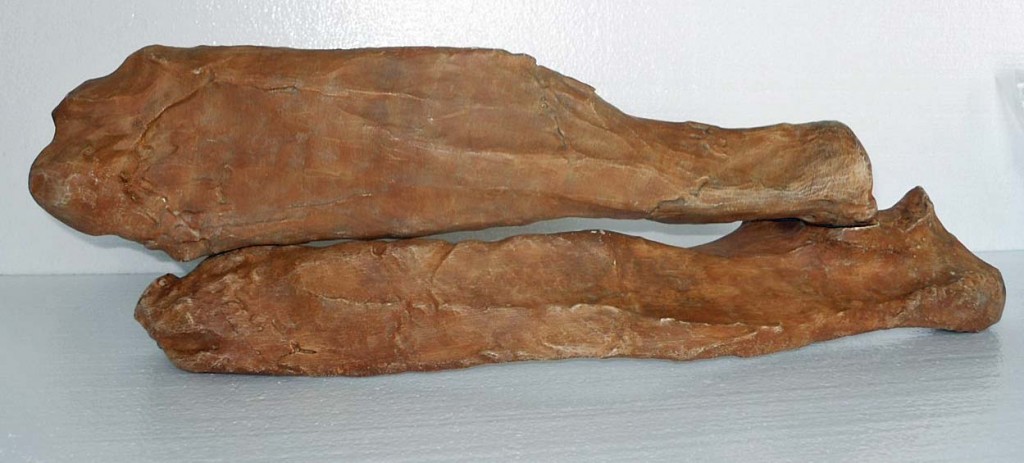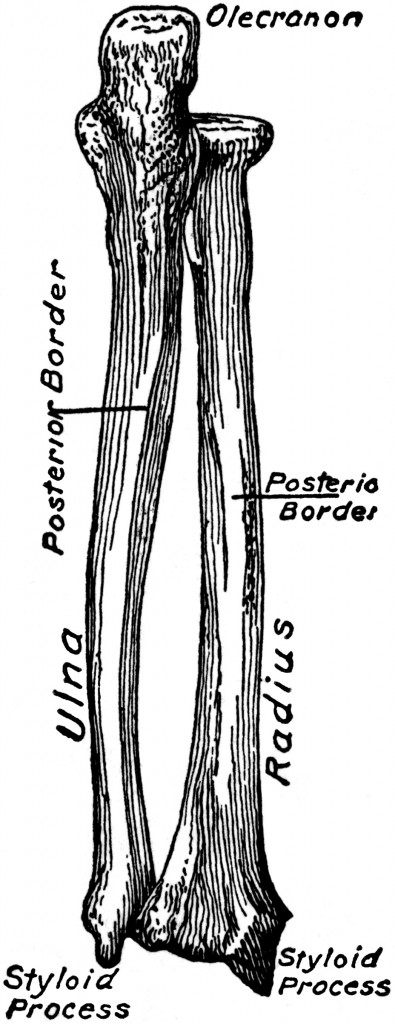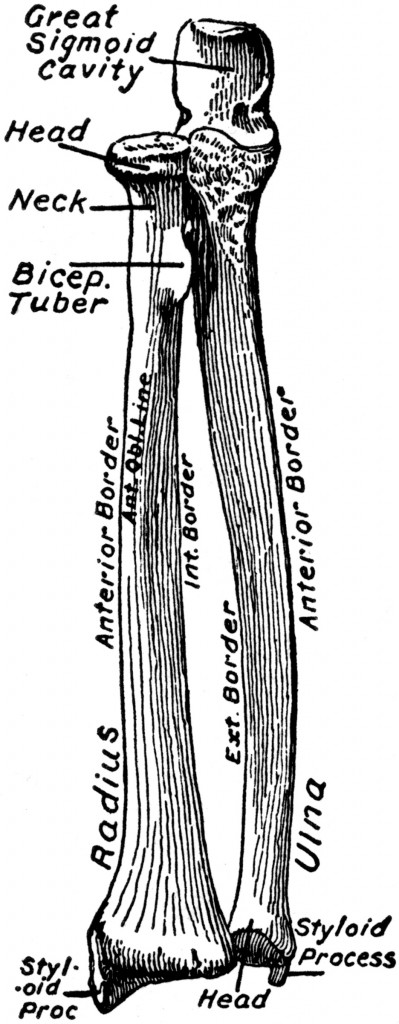Introduction to Walk Like a Sloth: lessons in ground sloth locomotion
 Getting Oriented
Getting Oriented
The lower arms of mammals have two bones–the radius on the thumb side and the ulna on the little finger side. The narrow end of the radius (also called the head) is the proximal or near end. If it looks like a small wheel, it is! The wheel turns in the radial notch of the ulna. Note that the articulating surface on the head of the radius covers about 75° of a circle; this wheel covers about 180° on the human radius, indicating more flexibility in humans than in Megalonyx. The large end is the wrist end; it has a small rough bump where a tendon anchors it to a corresponding spot on the end of the ulna. The shaft of the radius is notably triangular with a prominent interosseous crest (literally “between bones”) anchoring the muscles used to turn the paws up and down.
 Key points
Key points
#1 Front claws wouldn’t be much good for pulling down branches and stripping bark from trees if sloths couldn’t turn them in the direction they needed to reach and grasp things. As in humans, and unlike most other animals, the radius and ulna of a sloth’s lower arms are separated by a space for the muscles used to rotate the radius and turn its paws. The bones are solidly fused in runners like horses and gazelles.
#2 Note the bowing or curvature of the radius. Take a second look at the ulna. It is curved also, but in the opposite direction. The more curved these two bones are, and the wider the distance between them, the greater the power the muscles that turn the radius can generate. (Aiello and Dean, 1990) Compare the rugosity with the human radius. The sloth had one powerful lower arm!
 Additional information
Additional information
In three-toed sloths the area of the brain (cerebral cortex) devoted to controlling the forearm and paw is considerably larger than that for any of the other body part. This supports the theory ground sloths had the brain power in to coordinate the bones and muscles needed for fine-manipulation of the forearms. (Saraiva and Magalhaes-Castro, 1975)
Additional evidence suggesting superior paw control comes from the sloth’s face. Megalonyx is notable for  its lack of significant cranial (i.e. head and jaw) development anterior to (in front of) its front teeth (caniniforms). Other sloths had large mandibular spouts—long and/or wide flexible lips and tongues for gathering food but Megalonyx had the smallest spout of all the sloths in its family. (Vizcaíno, 2009) Most of the manipulation ability the sloth needed for foraging came from its paws, with a little help from its tongue and lips.
its lack of significant cranial (i.e. head and jaw) development anterior to (in front of) its front teeth (caniniforms). Other sloths had large mandibular spouts—long and/or wide flexible lips and tongues for gathering food but Megalonyx had the smallest spout of all the sloths in its family. (Vizcaíno, 2009) Most of the manipulation ability the sloth needed for foraging came from its paws, with a little help from its tongue and lips.
The radius is the bone most people break when they say they’ve suffered a broken “wrist.” It is one of the most common fractures, affecting 600,000 people per year in the United States, usually occurring about one (1) inch from the distal (far) end after falling on an outstretched arm. (Smith, 2013)
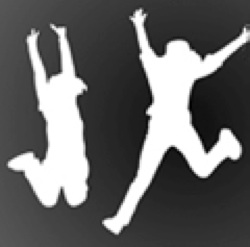 Things to do
Things to do
Move-like-a sloth. Hold your arm out palm down (thumb at 9 o’clock) your radius is the bone on the inside of your arm—the thumb side. Feel your elbow—that’s the end of the ulna—starting at the elbow and running down the outside of your arm toward your little finger. Now while still holding your elbow turn your hand palm sideways (thumb at 12:00)—your elbow didn’t move—it’s well locked down on the humerus or upper arm, but your radius is now on top. Muscles located on the ulna pulled on the radius and turned it, and with it your hand. Sloths probably couldn’t move their hands/paws any further, but you can—keep holding your elbow and turn your hand palm up 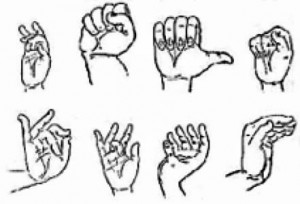 (thumb at 3:00)—your elbow still didn’t move, but the radius is on the outside now—magic! Sloths could shake hands with you, or motion you to have a seat (palm down), but they couldn’t hitch hike (because that requires holding their hands thumb out), ask for a handout (“gimme”), do a chin-up with palms in, or make a number of rude gestures with their palms facing in. Try some different hand gestures. Which ones can’t a sloth do? Is that a big handicap or can you figure out a different way of doing the same thing?
(thumb at 3:00)—your elbow still didn’t move, but the radius is on the outside now—magic! Sloths could shake hands with you, or motion you to have a seat (palm down), but they couldn’t hitch hike (because that requires holding their hands thumb out), ask for a handout (“gimme”), do a chin-up with palms in, or make a number of rude gestures with their palms facing in. Try some different hand gestures. Which ones can’t a sloth do? Is that a big handicap or can you figure out a different way of doing the same thing?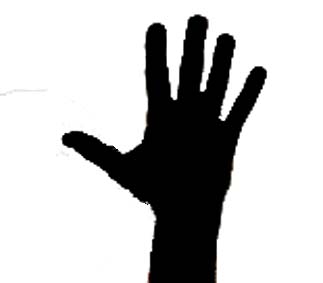
Flex Your Muscles Hold your right hand out, palm down in the prone position. Place your other hand in the crook of your right arm and now turn your arm clockwise until it’s in the supine position (remember “supine” by thinking about holding a bowl of soup). Can you feel a deep muscle flexing as you rotate your arm? That’s the biceps brachii muscle. Cep is Greek for “head,” and bi for “two.” The biceps has two heads or sites of origination on the scapula. The tendon of the muscle is attached to the biceps tuberosity on the radius. It is wrapped around the proximal radius in the prone position. When the muscle contracts it untwists the radius by pulling the tubersity back to facing forward. Note: the biceps serves a dual function by also flexing the elbow as in when you “make a muscle” with your arm.
Math Fun Archaeologists studying the remains of ancient people sometimes try to estimate their stature (height) from the partial skeletons that they often find. This can provide important clues about their diet and general health. Sometimes the archaeologists only find a radius. One formula they use is:
Height = 3.8 × Radius length (in inches) + 31.3 ± 2 inches.
Find a partner and measure each other’s radii (plural of radius, pronounced ray-dee-eye) by making a bicep muscle and measuring the inside of your arm from the crook of the elbow to the base of thumb. Do the math and compare the result to your actual height. Discuss—who came close (within 2 inches)? Was the formula a better predictor for boys or girls? Generally archaeologists don’t like using arm bones to make height estimates-leg bones are better predictors, but sometimes a radius is all they have. (Bass, 1971) Just for fun, measure the sloth’s radius. What does it predict for its height using the human formula? [19 1/4 in. translates to a estimate of 8 ft. 8 in ± 2 in. Not as tall as the ulna predicted, but still in the right range!]
The Jefferson Puzzle This is one of the bones Thomas Jefferson had available to try to figure out what kind of animal a sloth was. See the claw for a description of this activity.
 Things to think about
Things to think about
Think about digging, or pulling down branches or ripping the bark off a tree. [Mimic the motions] Is the sloth’s inability to turn its paws palm up a serious handicap or not? Is there anything important you can do that a sloth couldn’t by positioning its arm and paw in a different way?
Think about the word “radius.” Like many scientific words it comes from Latin and means “ray” or a spoke on the wheel of a chariot. Can you think of related words that also indicate a circle or sphere? [How about radial, radiate, radiant, radiation.]
 Future research
Future research
The seriousness of a fractured radius and the differences between the sexes and different ages makes this bone one of the most researched in the human body. Sloth scientists will be paying close attention to any diagnostic breakthroughs and applying any findings to fossils, and vice versa. It wouldn’t be the first time medicine has adopted techniques discovered by sloth researchers. Doctors developed many of their techniques for diagnosing and analyzing osteoporosis by studying sloth bones from La Brea. (Oxnard (1993) Because the fossils were rare and valuable, scientists couldn’t just cut them open, so they developed non-invasive ways of analyzing the fossils (e.g. X-rays, CT scans). Eventually they tried the same techniques on humans, making it possible today for doctors to diagnose the bone disease much earlier.
Conclusion
If the ulna is about reaching then the radius is about turning and manipulating the hand. Having a long reach wasn’t enough for Megalonyx to forage effectively, it also needed to get the food into its mouth. Without the long prehensile predental spout of other sloths, Megalonyx relied on better paw flexibility and eye-hand (paw) coordination. Arms may seem a odd place to look for evidence of locomotion but many anthropologists believe our manipulation ability evolved hand-in-hand with bipedalism. Could this be true in sloths too?
TO LEARN MORE ABOUT OR TO BORROW THE UNIVERSITY OF IOWA MUSEUM OF NATURAL HISTORY GEO-2-GO DISCOVERY TRUNKS CALL OR CONTACT THE MUSEUM.
References
Aiello, L. and Dean, C. 1990. Introduction to Human Evolutionary Anatomy. Academic Press Limited. San Diego, CA
Bass, W. M. (1971) Human Osteology: A laboratory and field manual of the human skeleton. University of Missouri. Columbia, MO.
Educational Technology Clearinghouse, Florida Center for Instructional Technology, College of Education, University of Southern Florida http://etc.usf.edu/clipart/
Oxnard, C. E. 1993. Bone and bones, architecture and stress, fossils and osteoporosis. Journal of Biomechanics 26, Supplement 1: 63-79.
Saraiva, P. E. S. and Magalhaes-Castro, B. 1975. Sensory and motor representation in the cerebral cortex of the three-toed sloth (Bradypus tridactylus). Brain Research 90: 181-193.
Smith, S. 2013. Wrist Blog. http://www.wristsupportbraces.com/wrist-blog/index.php/category/radius-fracture/
Vizcaíno, S. F. 2009. The teeth of the “toothless”: novelties and key innovations in the evolution of xenarthrans (Mammalia, Xenarthra). Paleobiology 35: 343-366.


